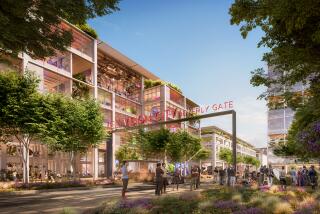In Santa Monica, Urban Bliss for Some Is a Call to Arms for Others
- Share via
It seems like the kind of neighborhood dispute that might be settled over some of restaurateur Hans Rockenwagner’s steamed white asparagus with prosciutto--served at the stammtisch, no less.
But to think it’s that simple is to underestimate the tensions of urban living, even if the locale is two blocks from the Pacific Ocean and around the corner from one of the highest-rated restaurants in the Los Angeles area.
The passionate dispute centers on the Ocean Park neighborhood of Santa Monica. The argument is whether the Edgemar complex--an expanse of building and courtyard that houses a Ben & Jerry’s outpost, the Rockenwagner restaurant and a vacant museum space on Main Street--can be changed. Developers want to add 12 seats inside the restaurant and 14 on the patio, transform the empty museum into two small performance theaters, and create two artists studios.
The Santa Monica City Council will decide whether to grant all the complicated zoning changes. Hoping for a favorable recommendation, advocates and critics last week took their pleas to the city’s Planning Commission, a sober-faced, casually dressed group with enough stamina to sit for six hours in City Council chambers wrestling with this issue until 1 in the morning.
The night of struggle was an example of how one person’s cozy neighborhood hangout is another person’s invasion of that cozy neighborhood’s serenity.
The history of the Edgemar dispute is rocky. For years, some 2nd Street residents whose property sits directly behind the complex say they have suffered through noise, the frenzied traffic of desperate valets searching for parking spaces and the lackluster efforts of the developer, Abby Sher, and restaurateur Rockenwagner to change any of this.
When the neighbors alerted city officials that Rockenwagner was violating his 75-person seating limit by serving additional patrons on the patio as well as at the massive slab of a community table, inspectors came in and put the kibosh on the stammtisch (German for “table of regulars”).
Rockenwagner was so upset over the loss of the extra seats that he threatened to move his restaurant if he did not receive official permission for additional seating.
Rockenwagner’s patrons--foodies and other sophisticated urbanites, some of whom drive 20 miles for his cuisine--were so distraught over the possible loss of their favorite restaurant that they protested in droves at two Planning Commission hearings.
Meanwhile, residents brought statements--even photographs--to the commission meetings to document their claims that the installation of two theaters, artists lofts and more restaurant seating would lead to increased noise and parking troubles at the complex, a stark gray Frank Gehry design that had once been a lowly egg factory.
*
“In the 15 years since Edgemar opened,” complained Jeff Gilbert, a 2nd Street resident, “I have not slept through the night once.”
Gilbert went through a litany of some of the problems that the residents have documented: traffic in the middle of the night, often from scavengers hunting for empty bottles put out by the restaurant owner . . . traffic and noise from revelers attending special events at the museum space that was sometimes rented out for parties . . . noise from the loading dock.
“I was awakened early one morning by people removing Porta Potties,” Gilbert said.
Neighbors contend that the hard edges of the complex amplify noise. Said one resident about the proposed theaters: “We will hear every round of applause and every musical production.”
*
Even Rockenwagner’s expansion from 75 to 101 seats would be a nuisance, residents said. “It means 30% more dumping of garbage, 30% more bottles being put out,” Pam Todd said.
“This is not inexpensive property,” resident Lou Anne Neill said of the neighborhood. “We work very hard to get and maintain this property.”
The patrons who love Rockenwagner were aghast.
“Community is what Santa Monica is all about, and I can’t think of anyone who has helped create that more than Hans Rockenwagner,” said Lawrence Leone, a writer and lawyer who lives on 4th Street. “Why is there a Seder at the restaurant and the restaurant is closed for that? He loses money that night.”
It may be difficult to reconcile “neighborhood hangout” with an acclaimed restaurant that draws people from across the city and serves a $27 asparagus main course. (“Once again it’s asparagus season which we at Rockenwagner take very seriously,” reads the current menu.) But to some people in Santa Monica, it really is that. They go every week. Some walk from their houses or apartments. Turnover is slow and infrequent; people sit for hours talking with friends and Rockenwagner.
“Everyone lives here for a different reason and everyone makes a sacrifice,” said plastic surgeon Steven Teitelbaum, one local Rockenwagner habitue. “Some people come to surf, and some people are bothered by surfers going by early in the morning. But everyone has made a voluntary decision to live here. If they don’t like it, they can leave. . . . I ask the neighbors: ‘Think about how much you really will be impacted. Nothing that replaces him will be any better.’ ”
*
There was so much outpouring of support for the restaurant at Wednesday night’s planning commission meeting that when Rockenwagner finally spoke, he seemed compelled to explain it.
“You would think, ‘What did I put in their food to make them speak out this way?’ ” he said. He took pains to be humble. “I want to address my neighbors’ concerns. I don’t want to alienate people who could be my customers. . . . I do not want to relocate.”
Somewhere between the neighbors and the restaurant aficionados were the theater supporters, some of whom seemed perplexed that a neighborhood would turn away a serious small theater.
“We only exist to enrich the lives of people who walk through those doors and the people who do the theatrical work,” said film actor Ed Harris, who is on the board of the Loretta Theatre, the dramatic company that hopes to inhabit the two spaces. “It’s not about making noise. It’s not about partying. It’s only about doing the work we like.”
In the end, planning commissioners voted to recommend that the City Council approve the theater spaces, the lofts and the restaurant seating expansion. However, they required the developers to measure noise levels and possibly install noise-muting materials.
“There has been a long history of violations on the site--outdoor entertainment or activities that go beyond the hours of the permit,” noted Suzanne Frick, the city’s director of planning and community development. “But at the same time, there has been a group of overly sensitive neighbors.”
Even as the commission voted its accord for the plans, one commissioner lamented the hostility that had built between people who live and work and play essentially next to each other.
“If anything good comes out of this process,” said Commissioner Frank Gruber, an attorney, “maybe it’s that at least people are talking to each other.”
More to Read
Sign up for Essential California
The most important California stories and recommendations in your inbox every morning.
You may occasionally receive promotional content from the Los Angeles Times.











